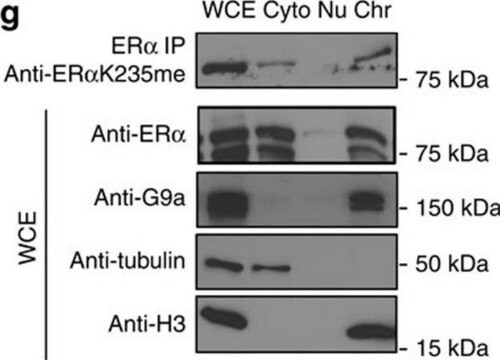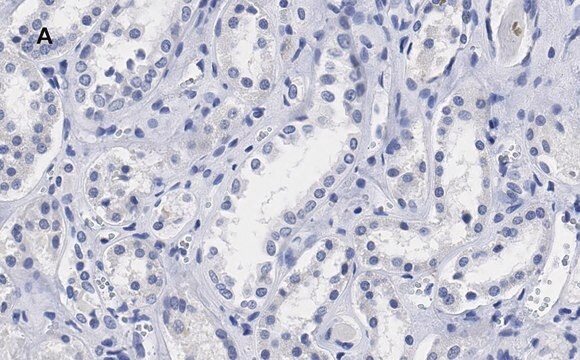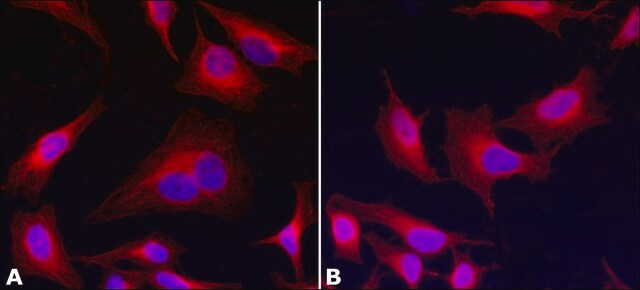05-661-I
Anti-β-Tubulin Antibody, clone AA2
Sinónimos:
Tubulin beta-5 chain;beta-Tubulin
About This Item
Productos recomendados
biological source
mouse
Quality Level
conjugate
unconjugated
antibody form
purified antibody
antibody product type
primary antibodies
clone
AA2, monoclonal
mol wt
calculated mol wt 49.67 kDa
observed mol wt ~50 kDa
purified by
using protein G
species reactivity
rabbit, rat, mouse, bovine, hamster, human
packaging
antibody small pack of 100 μg
technique(s)
immunocytochemistry: suitable
immunofluorescence: suitable
immunohistochemistry (formalin-fixed, paraffin-embedded sections): suitable
western blot: suitable
isotype
IgG1κ
epitope sequence
C-terminal
Protein ID accession no.
UniProt accession no.
shipped in
ambient
target post-translational modification
unmodified
Gene Information
bovine ... TUBB5(615087)
General description
Specificity
Immunogen
Application
Evaluated by Western Blotting in A431 cell lysates.
Western Blotting Analysis: A 1:1,000 dilution of this antibody detected β-Tubulin in A431 cell lysates.
Tested Applications
Immunofluorescence Analysis: A representative lot detected β-Tubulin in Immunofluorescence applications (Abdelfattah, N., et al. (2018). Nat Commun. 9(1):4541; Kelly, J.J., et al. (2015). J Cell Sci. 128(21):3947-60; Moreira, B.P., et al. (2017). J Cell Sci. 130(6):1179-1193; Verbist, K.C., et al. (2016). Nature. 532(7599):389-93).
Immunocytochemistry Analysis: A representative lot detected β-Tubulin in Immunocytochemistry applications (Verbist, K.C., et al. (2016). Nature. 532(7599):389-93).
Western Blotting Analysis: A representative lot detected β-Tubulin in Western Blotting applications (Abdelfattah, N., et al. (2018). Nat Commun.;9(1):4541; Cho, J-H., et al. (2017). Nat Commun. 8(1):1848; Moreira, B.P., et al. (2017). J Cell Sci. 130(6):1179-1193; Ohshiro, K., et al. (2020). Genes Cancer. 11(1-2):43-52; Rawlinson, S.M., et al. (2018). Nat Commun. 9(1):3057; Shrestha, P., et al. (2020). Nat Neurosci. 23(2):281-292; Terzaghi, L., et al. (2018). Reproduction. 155(3):273-282; Villar-Fincheira, P., et al. (2021). Front Physiol.12:722528).
Immunohistochemistry Applications: A representative lot detected β-Tubulin in Immunohistochemistry applications (Cho, J-H., et al. (2017). Nat Commun. 8(1):1848).
Note: Actual optimal working dilutions must be determined by end user as specimens, and experimental conditions may vary with the end user
Physical form
Storage and Stability
Other Notes
Disclaimer
¿No encuentra el producto adecuado?
Pruebe nuestro Herramienta de selección de productos.
Storage Class
12 - Non Combustible Liquids
wgk_germany
WGK 1
flash_point_f
Not applicable
flash_point_c
Not applicable
Certificados de análisis (COA)
Busque Certificados de análisis (COA) introduciendo el número de lote del producto. Los números de lote se encuentran en la etiqueta del producto después de las palabras «Lot» o «Batch»
¿Ya tiene este producto?
Encuentre la documentación para los productos que ha comprado recientemente en la Biblioteca de documentos.
Nuestro equipo de científicos tiene experiencia en todas las áreas de investigación: Ciencias de la vida, Ciencia de los materiales, Síntesis química, Cromatografía, Analítica y muchas otras.
Póngase en contacto con el Servicio técnico








